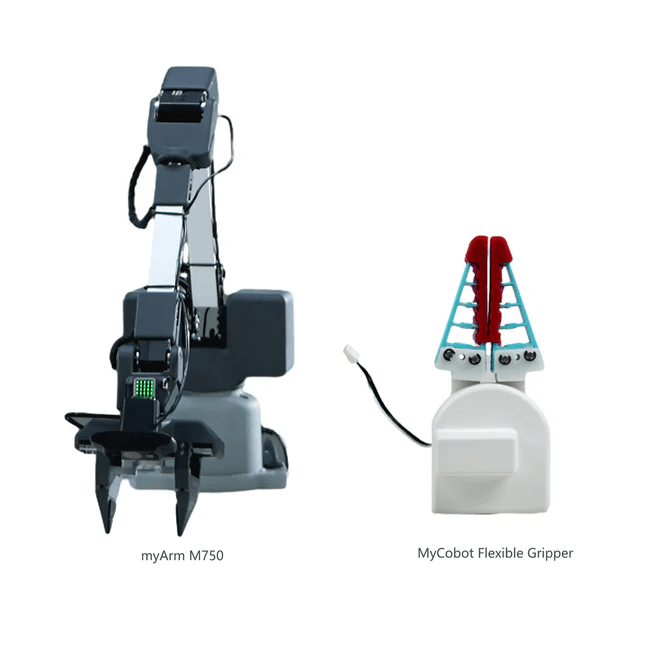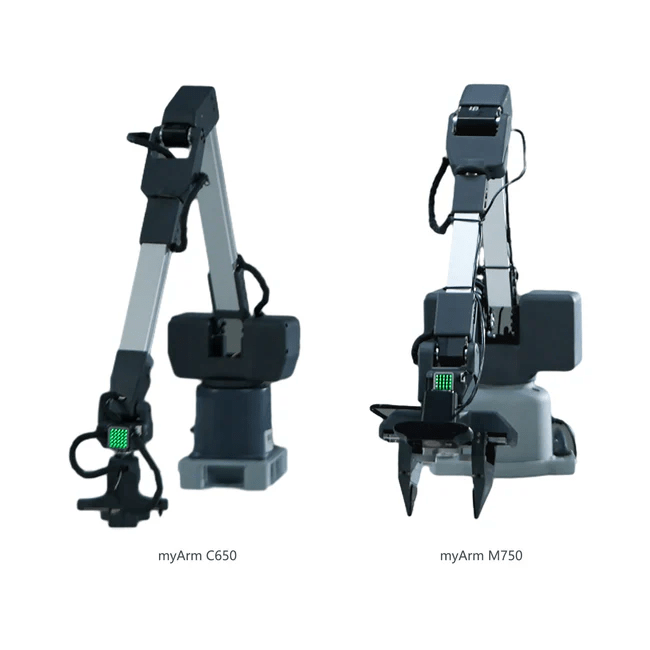Entdecken Sie die Roboter der myArm M&C-Serie für vielseitige, leistungsstarke Lösungen in der Robotik, die eine präzise Steuerung und vielfältige Anwendungen bieten.
SHENZHEN, GUANGDONG, CHINA, 10. Mai 2024 /EINPresswire.com/ — Die Forschung zur verkörperten Intelligenz als kritischer Zweig der künstlichen Intelligenz ist bestrebt, Roboter mit neuen Fähigkeiten für präzise Bewegungssteuerung, autonome Entscheidungsfindung auf hohem Niveau und nahtlose Mensch-Maschine-Interaktion auszustatten.
Vor diesem Hintergrund hat Elephant Robotics kürzlich die Roboter der M&C-Serie myArm vorgestellt. Diese leistungsstarken und kostengünstigen Leichtbauroboter unterstützen Forscher und Entwickler sowohl bei der Datenerfassung als auch bei der Ausführung und treiben die Fortschritte in der Technologie der verkörperten Intelligenz und ihrer praktischen Anwendungen voran.
Die Roboter der myArm M&C-Serie wurden sorgfältig entwickelt, um die unterschiedlichen Bedürfnisse der Benutzer zu erfüllen, wobei Flexibilität und Anpassungsfähigkeit im Vordergrund stehen. Sie spielen eine zentrale Rolle in verschiedenen Forschungs- und Anwendungsszenarien und sind damit die ideale Robotiklösung für Bildungs- und Forschungszwecke.
myArm C650
The myArm C650 ist ein universelles 6-DOF-Gerät zur Erfassung von Roboterbewegungsinformationen, das entwickelt wurde, um die vielfältigen Anforderungen von Bildung, Forschung und Industrie bei der Erfassung und Analyse von Roboterbewegungsdaten zu erfüllen. Mit seinem leichten Design von nur 1,8 kg verfügt der myArm C650 über einen horizontalen Arbeitsradius von 650 mm, wodurch die Trägheitskräfte während des Betriebs minimiert werden, um die Reaktionsgeschwindigkeit und Präzision zu verbessern.
Ausgestattet mit hochpräzisen digitalen Servomotoren und 4096-Bit-Encodern an allen 6 Gelenken ahmt der myArm C650 die Bewegung des menschlichen Arms mit bemerkenswerter Genauigkeit nach und ermöglicht so eine Vielzahl von Aufgaben. Seine intuitive Steuerungsmethode mit Doppelfinger-Fernbedienung und zwei anpassbaren Tasten unterstützt Aufzeichnungsfunktionen für eine präzise Befehlsausführung und sofortiges Feedback zum Roboterverhalten. Diese Flexibilität macht den myArm C650 zur idealen Wahl für die präzise Bewegungsverfolgung und Datenerfassung in verschiedenen experimentellen und pädagogischen Umgebungen. Mit einer beeindruckenden Informationserfassungsgeschwindigkeit von bis zu 50 Hz ist es für die Entwicklung von Roboteralgorithmen und Hochschuleinrichtungen unverzichtbar geworden und bietet Echtzeit-Datenunterstützung für komplexe Steuerungssysteme.
Bei Fernsteuerungsanwendungen zeichnet sich der myArm C650 durch eine hervorragende Leistung aus, unabhängig von der Komplexität der Konfiguration des Roboters. Darüber hinaus erweitert die Kompatibilität mit Python und ROS in Verbindung mit Open-Source-Demonstrationsdateien für die Fernsteuerung den Anwendungsbereich und ermöglicht eine nahtlose Integration mit fortschrittlichen Roboterplattformen wie dem myArm M750, myCobot Pro 630 und Mercury B1.
Der myArm C650 setzt einen neuen Standard für Vielseitigkeit und Leistung bei der Erfassung von Roboterbewegungsdaten und ermöglicht es Benutzern, das volle Potenzial fortschrittlicher Robotik in verschiedenen Bereichen auszuschöpfen.
myArm M750
Der myArm M750 ist ein universeller, intelligenter 6-DOF-Roboterarm. Es erfüllt nicht nur die Nachfrage nach hochpräziser Roboterbewegungssteuerung, sondern eignet sich besonders für die Verifizierung von Roboterbewegungsalgorithmen auf Einstiegsniveau und praktische Lehrszenarien. Seine standardisierte mechanische Armstruktur bietet Studenten und Anfängern eine ideale Lernplattform, um die Grundprinzipien und Anwendungen der Roboterkinematik zu verstehen.

Der myArm M750 wurde für eine präzise Bewegungssteuerung und -verifizierung entwickelt und eignet sich hervorragend für Anwendungen, die eine strenge Betriebsgenauigkeit erfordern, wie z. B. Präzisionsmontage, Feinmanipulation und Qualitätsüberwachung. Ausgestattet mit hochpräzisen digitalen Servomotoren in Industriequalität und fortschrittlichen Steuerungsalgorithmen bietet der myArm M750 eine außergewöhnliche Drehmomentsteuerung und Positionsgenauigkeit und unterstützt eine Nenntragfähigkeit von 500 g und eine Spitzenlast von bis zu 1 kg.
Die Vielseitigkeit des myArm M750 erstreckt sich auch auf das Endeffektor-Design, das mit einem standardmäßigen Parallelgreifer und einem Vision-Modul ausgestattet ist, das dem Benutzer grundlegende Greif- und Erkennungsfunktionen bietet. Darüber hinaus bietet der myArm M750 Kompatibilität mit einer Reihe von optionalem Zubehör, was seine Anwendungsszenarien und Anpassungsfähigkeit an verschiedene Aufgaben erheblich erweitert.
myArm M&C Teleoperation Roboterarm-Kit
DasTeleoperation Robotic Arm Kit stellt einen Sprung nach vorne in der Robotik-Innovation dar und bietet eine fortschrittliche Lösung, die auf die Fernsteuerung und Echtzeit-Interaktion durch modernste Teleoperationstechnologie zugeschnitten ist. Durch die nahtlose Integration der Vielseitigkeit des myArm C650 mit den präzisen Steuerungsfunktionen des myArm M750 bildet dieses Kit eine dynamische und anpassungsfähige Plattform, die für eine Vielzahl von Forschungs-, Bildungs- und kommerziellen Anwendungen geeignet ist.

Das Kit wurde entwickelt, um menschliches Verhalten nachzuahmen, und ermöglicht es Forschern und Entwicklern, Fernsteuerungssysteme und Roboterbewegungsplanungsmodelle ähnlich dem ALOHA-Roboter zu validieren und zu testen. Das myArm M&C Kit verfügt über Datenerfassungs- und Steuerungsfunktionen auf Millisekundenebene, Echtzeit-Widerstandssteuerungsfunktionen und kollaborative Betriebsfunktionen mit mehreren Robotern und erleichtert die Ausführung komplexer Aufgaben, einschließlich fortschrittlicher Simulationen menschlichen Verhaltens. Diese Technologie zeigt nicht nur die Präzision und Effizienz von Robotern bei der Nachahmung menschlicher Handlungen, sondern treibt auch die Forschung und Entwicklung in der Robotertechnologie zur Simulation menschlichen Verhaltens und zur Ausführung alltäglicher Aufgaben voran.

Darüber hinaus stattet die integrierte KI-Technologie Roboter mit Lern- und Anpassungsfähigkeit aus, ermöglicht autonome Navigation, Objekterkennung und komplexe Entscheidungsfähigkeiten und erschließt so ein enormes Anwendungspotenzial in verschiedenen Forschungsbereichen.
myArm M&C Embodied humanoid Robot Compound Kit
Das Mobile ALOHA-Projekt der Stanford University hat aufgrund seiner bahnbrechenden Fortschritte in der Robotiktechnologie weltweite Aufmerksamkeit erregt. Es hat ein fortschrittliches System entwickelt, das es Benutzern ermöglicht, komplexe zweiarmige Aufgaben durch menschliche Demonstrationen auszuführen und so die Effizienz von nachgeahmten Lernalgorithmen durch Datenakkumulation und kollaboratives Training zu verbessern. Das Mobile ALOHA-System zeigt seine Vielseitigkeit, indem es verschiedene reale Aufgaben nahtlos ausführt, vom Reinigen verschütteter Getränke über das Kochen von Garnelen bis hin zum Waschen von Bratpfannen. Diese Innovation markiert nicht nur einen bedeutenden Meilenstein in der Robotik, sondern ebnet auch den Weg für eine Zukunft, in der Mensch und Roboter harmonisch koexistieren.

Dieses Kit wurde von Stanfords Mobile ALOHA-Projekt inspiriert und verwendet das gleiche mobile Tracer-Fahrgestell. Mit einer Open-Source-Philosophie, minimalistischem Design, modularem Aufbau und robuster lokaler Community-Unterstützung dient dieses Kit als kostengünstige Lösung für die Echtzeit-Roboterteleoperation und -steuerung und spiegelt die Fähigkeiten von Mobile ALOHA zu einem erschwinglicheren Preis wider.
Dieses Kit wurde entwickelt, um den Bedürfnissen kleiner und mittlerer Unternehmen sowie Bildungs- und Forschungseinrichtungen gerecht zu werden, und bietet einen erschwinglicheren Preis, benutzerfreundliche Funktionen und einen einfachen Zugang zu modernster Robotertechnologie.
Die Roboter der myArm M&C-Serie sind eine vielseitige Robotiklösung, die unterschiedliche Anforderungen erfüllt, von der Grundlagenforschung bis hin zur Ausführung komplizierter Aufgaben. In Kombination mit optionalen Kits passen sie sich nahtlos an verschiedene Anwendungsszenarien an, von der Präzisionsfertigung über medizinische Hilfe bis hin zu Bildung, Schulung und Haushaltsunterstützung. Die Roboter der myArm M&C-Serie zeichnen sich durch zuverlässige und leistungsstarke Lösungen aus, die Zuverlässigkeit und Exzellenz versprechen. Die Aufnahme des Embodied Humanoid Robot Compound Kit und des Quadruped Bionic Robot Compound Kit erweitert die Möglichkeiten in der Robotik weiter, fördert die interdisziplinäre Erforschung und fördert Innovationen.























